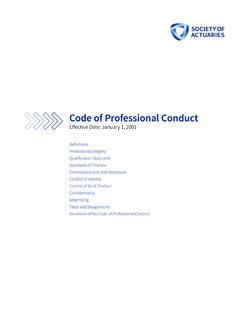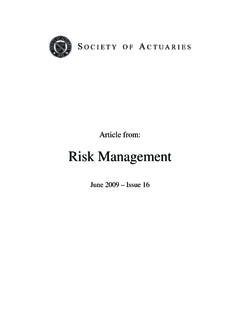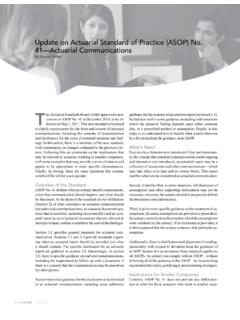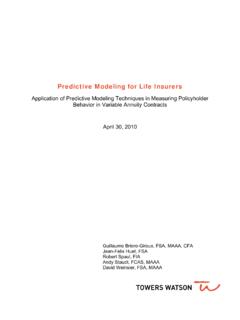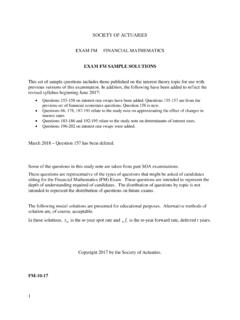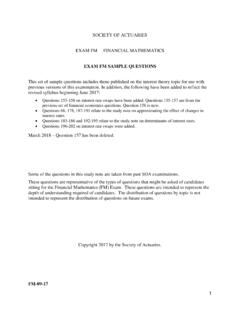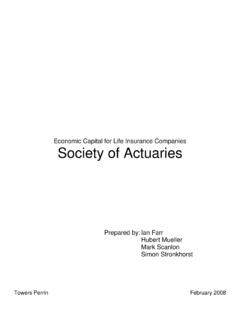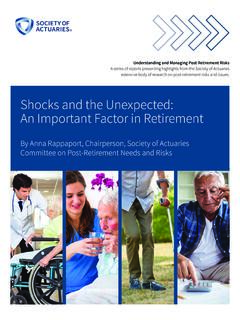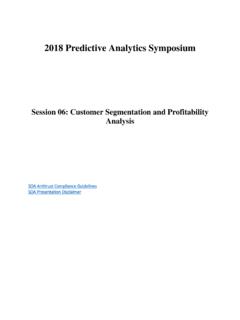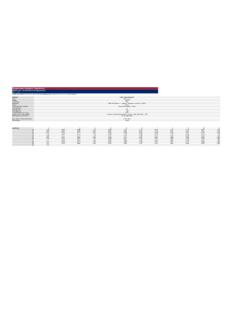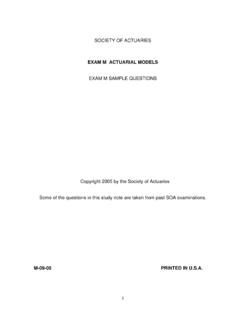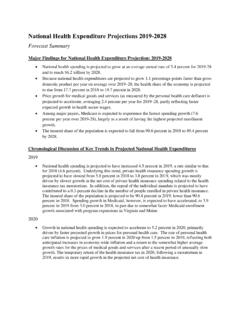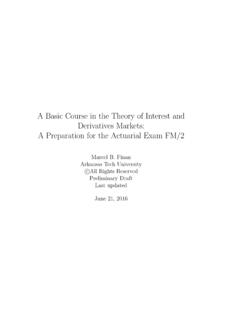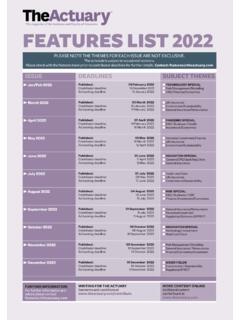Transcription of EXAM P SAMPLE QUESTIONS - MEMBER | SOA
1 Page 1 of 138 SOCIETY OF ACTUARIES EXAM P PROBABILITY EXAM P SAMPLE QUESTIONS This set of SAMPLE QUESTIONS includes those published on the probability topic for use with previous versions of this examination. QUESTIONS from previous versions of this document that are not relevant for the syllabus effective with the September 2022 administration have been deleted. The QUESTIONS have been renumbered. Unless indicated below, no QUESTIONS have been added to the version published for use with exams through July 2022. Some of the QUESTIONS in this study note are taken from past SOA examinations. These QUESTIONS are representative of the types of QUESTIONS that might be asked of candidates sitting for the Probability (P) Exam.
2 These QUESTIONS are intended to represent the depth of understanding required of candidates. The distribution of QUESTIONS by topic is not intended to represent the distribution of QUESTIONS on future exams. QUESTIONS 271-287 were added July 2022. QUESTIONS 288-319 were added August 2022. Copyright 2022 by the Society of Actuaries. Page 2 of 138 1. A survey of a group s viewing habits over the last year revealed the following information: (i) 28% watched gymnastics (ii) 29% watched baseball (iii) 19% watched soccer (iv) 14% watched gymnastics and baseball (v) 12% watched baseball and soccer (vi) 10% watched gymnastics and soccer (vii) 8% watched all three sports.
3 Calculate the percentage of the group that watched none of the three sports during the last year. (A) 24% (B) 36% (C) 41% (D) 52% (E) 60% 2. The probability that a visit to a primary care physician s (PCP) office results in neither lab work nor referral to a specialist is 35%. Of those coming to a PCP s office, 30% are referred to specialists and 40% require lab work. Calculate the probability that a visit to a PCP s office results in both lab work and referral to a specialist. (A) (B) (C) (D) (E) 3. You are given [] B = and [] B =. Calculate P[A]. (A) (B) (C) (D) (E) Page 3 of 138 4. An urn contains 10 balls: 4 red and 6 blue.
4 A second urn contains 16 red balls and an unknown number of blue balls. A single ball is drawn from each urn. The probability that both balls are the same color is Calculate the number of blue balls in the second urn. (A) 4 (B) 20 (C) 24 (D) 44 (E) 64 5. An auto insurance company has 10,000 policyholders. Each policyholder is classified as (i) young or old; (ii) male or female; and (iii) married or single. Of these policyholders, 3000 are young, 4600 are male, and 7000 are married. The policyholders can also be classified as 1320 young males, 3010 married males, and 1400 young married persons. Finally, 600 of the policyholders are young married males.
5 Calculate the number of the company s policyholders who are young, female, and single. (A) 280 (B) 423 (C) 486 (D) 880 (E) 896 6. A public health researcher examines the medical records of a group of 937 men who died in 1999 and discovers that 210 of the men died from causes related to heart disease. Moreover, 312 of the 937 men had at least one parent who suffered from heart disease, and, of these 312 men, 102 died from causes related to heart disease. Calculate the probability that a man randomly selected from this group died of causes related to heart disease, given that neither of his parents suffered from heart disease. (A) (B) (C) (D) (E) Page 4 of 138 7.
6 An insurance company estimates that 40% of policyholders who have only an auto policy will renew next year and 60% of policyholders who have only a homeowners policy will renew next year. The company estimates that 80% of policyholders who have both an auto policy and a homeowners policy will renew at least one of those policies next year. Company records show that 65% of policyholders have an auto policy, 50% of policyholders have a homeowners policy, and 15% of policyholders have both an auto policy and a homeowners policy. Using the company s estimates, calculate the percentage of policyholders that will renew at least one policy next year.
7 (A) 20% (B) 29% (C) 41% (D) 53% (E) 70% 8. Among a large group of patients recovering from shoulder injuries, it is found that 22% visit both a physical therapist and a chiropractor, whereas 12% visit neither of these. The probability that a patient visits a chiropractor exceeds by the probability that a patient visits a physical therapist. Calculate the probability that a randomly chosen MEMBER of this group visits a physical therapist. (A) (B) (C) (D) (E) Page 5 of 138 9. An insurance company examines its pool of auto insurance customers and gathers the following information: (i) All customers insure at least one car.
8 (ii) 70% of the customers insure more than one car. (iii) 20% of the customers insure a sports car. (iv) Of those customers who insure more than one car, 15% insure a sports car. Calculate the probability that a randomly selected customer insures exactly one car and that car is not a sports car. (A) (B) (C) (D) (E) 10. An actuary studying the insurance preferences of automobile owners makes the following conclusions: (i) An automobile owner is twice as likely to purchase collision coverage as disability coverage. (ii) The event that an automobile owner purchases collision coverage is independent of the event that he or she purchases disability coverage.
9 (iii) The probability that an automobile owner purchases both collision and disability coverages is Calculate the probability that an automobile owner purchases neither collision nor disability coverage. (A) (B) (C) (D) (E) Page 6 of 138 11. A doctor is studying the relationship between blood pressure and heartbeat abnormalities in her patients. She tests a random SAMPLE of her patients and notes their blood pressures (high, low, or normal) and their heartbeats (regular or irregular). She finds that: (i) 14% have high blood pressure. (ii) 22% have low blood pressure. (iii) 15% have an irregular heartbeat. (iv) Of those with an irregular heartbeat, one-third have high blood pressure.
10 (v) Of those with normal blood pressure, one-eighth have an irregular heartbeat. Calculate the portion of the patients selected who have a regular heartbeat and low blood pressure. (A) 2% (B) 5% (C) 8% (D) 9% (E) 20% 12. An actuary is studying the prevalence of three health risk factors, denoted by A, B, and C, within a population of women. For each of the three factors, the probability is that a woman in the population has only this risk factor (and no others). For any two of the three factors, the probability is that she has exactly these two risk factors (but not the other). The probability that a woman has all three risk factors, given that she has A and B, is 1/3.
